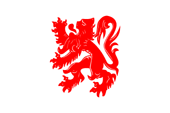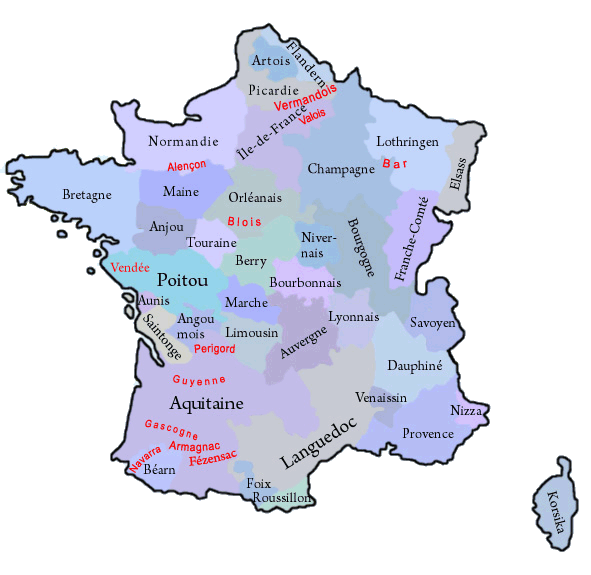mobile View, to the German Version tap the flag


- historical region in today's France
- former county
• Flag
• Meaning/Origin of the Flag
• Coat of Arms
• Meaning/Origin of the Coat of Arms
• Map of the historical Regions in France
• Explanations about the Regions
• History
• Origin of the Country's Name

Flag of Fézensac




The flag of Armagnac is a theoretical scutcheon-flag, its design is the image of the coat of arms, which has been used in the 10th century.
Source:
Volker Preuß,
Wikipedia (D)


10.-12th cent.,
Coat of arms of Fézensac
– Blason du Fézensac,
Source, by:
Wikipedia (FR)

The coat of arms of Fézensac dates from the 10th century, when the County of Fézensac was divided as heritage between two sons. The senior kept the County of Fézensac – just territorially reduced – the younger brother received the newly created County of Armagnac. Both counties used the same coat of arms. It showed a red lion on silver. In 1140 Count Geraud III. united his county of Armagnac with the County of Fézensac, because he had remained without a male heir, but the name Armagnac and the coat of arms were maintained.
Source:
Wikipedia (FR),
Wikipedia (DE),
Volker Preuß

The historical, French Regions:

in black: governorate and province in 1776,
in red: former county, province oder governorate
Map: Volker Preuß

The until the French Revolution existing provinces (or governorates) have been historically grown structures, which had their roots oftenly in former fiefdoms of the French crown, historic counties and duchies. They oftenly existed for hundreds of years and had preserved regionality (e.g. cultural particularities and regional languages). On the occasion of the French Revolution such phenomena were of course not desirable, and as part of their bloody and violent egalitarianism any regional references were eliminated. Shortly after the French Revolution the provinces were dissolved and France became divided into many départements, which should have approximately the same size and the same status. The départements were named after rivers or mountains, to use never and in no circumstances the name of an old province. However, there was no success in cutting the connections of the people of France to their respective regions, so that administrative regions were re-created in 1960, to have a better control in regional administrative processes. In this way became départements, which were placed in a historical province, administratively grouped to an oftenly historically named region. The resulted structures coincide only approximately with the boundaries of the old provinces. In the strictly centralist France any regionality is avoided, so that even the official flags of these regions mostly look like flags of companies, unloving, unhistorical, technocratic and modernistic, and these flags should not be a subject of any lexical considerations here. Only in a few of that regions, exist official flags which remember the historical models. But, even the existence of these today's regions is douptful, because in 2014 was passed a territorial reform valid from the year 2016, that reduces the number of the existing regions by merging to nearly the half. However, there exist unofficial flags in nearly all of these regions, which should remember the old provinces and the old heraldry.
Wikipedia Link to the regions of France:
click or tap here
FOTW Link to the regions of France:
click or tap here
Source: Flags of the World,
Wikipedia (D),
Volker Preuß

Prehistory · see Armagnac
771 · Charlemagne takes over Aquitaine and transmits it later as a kingdom to his youngest son Louis the Pious, Charlemagne estblishes the County of Fézensac to counter the repeated revolts of the Basques against the rule of the Carolingians, the first mentioned Carolingian count is Leuthard of Paris (House of Matfriede)
819 · King Pepin I. of Aquitaine appoints Aznar Sanche to the Count of Gascony
836 · the County of Fézensac is owned again by the Basques, it belongs to the Basque Gascony and develops into its central part
848 · Count Sanche Mitarrat calls himself a Duke
920 · death of Garcia Sanchez le Tors, the heritage (the duchy of Gascony) is divided among his three sons, the majority of Gascony comes to Sancho III., the Counties of Astarac and Fézensac come to the other brothers – after the death of William Garcia, Count of Fézensac, the county is divided among the sons, the elder son Othon receives the county Fézensac, his younger brother Bernard le Louche receives the by the division newly created County of Armagnac
1140 · Count Geraud III. of Armagnac unites his county with the County of Fézensac because he had remained without a male heir
subsequent history · see Armagnac
Source:
Wikipedia (D),
Meyers Konversationslexikon

The geographical names Armagnac and Fézensac are of Basque-Occitan origin and difficult to explain. Supposedly, however, the name Armagnac should be an old family name, after that the area was named.
Source:
Handbuch der geographischen Namen,
Volker Preuß


![]()






